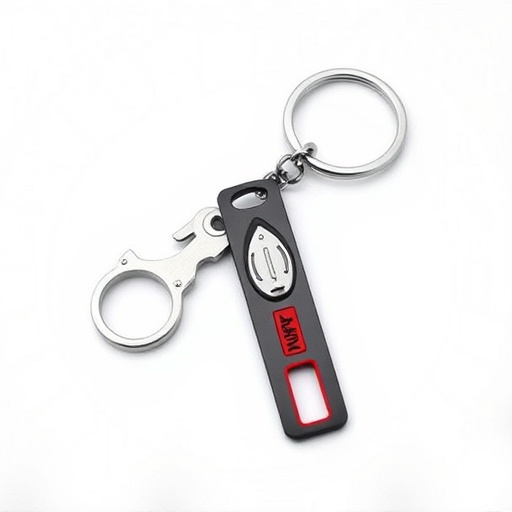When designing a tactical keychain self-defense tool, prioritize durable corrosion-resistant metals like stainless steel or titanium for longevity and strength. Incorporate textured patterns for better grip and control, with a contoured design to reduce strain. Include sharp edges, removable hooks, flashlights, and sound signals for enhanced self-defense capabilities. Balance size, weight, and comfort for easy carrying without feeling cumbersome. Conduct real-world testing for grip, durability, weather resistance, and self-defense scenarios. Collaborate with experts for refinement based on practical feedback.
Looking to upgrade your self-defense game with a tactical keychain? This guide breaks down the essential tips for designing a durable, grippable, and effective metal defense keychain. From selecting corrosion-resistant materials to incorporating tactical features, we explore how to balance functionality and comfort. Learn about size optimization, real-world testing, and more, transforming your everyday keychain into powerful self-defense tools.
- Choosing the Right Metal for Durability and Corrosion Resistance
- Design Considerations for Optimal Grip and Control
- Incorporating Tactical Features for Enhanced Self-Defense
- Size and Weight Balance: Ensuring Practicality and Comfort
- Testing and Refining Your Keychain's Performance in Real-World Scenarios
Choosing the Right Metal for Durability and Corrosion Resistance
When designing a tactical keychain self-defense tool, selecting the appropriate metal is paramount for ensuring both durability and corrosion resistance. Opting for high-quality metals like stainless steel or titanium can significantly enhance the longevity of your keychain. These materials possess exceptional strength-to-weight ratios, making them ideal for intense use without compromising structure. Moreover, they are less susceptible to rust and pitting, even in challenging environments.
Corrosion resistance is a critical factor when considering tactical self-defense tools, as exposure to moisture or harsh conditions can weaken cheaper metal options. Stainless steel, in particular, offers excellent corrosion protection due to its chromium content, which forms a protective layer on the surface. This feature ensures your keychain remains reliable and functional, even after prolonged use and exposure to various elements.
Design Considerations for Optimal Grip and Control
When designing a tactical keychain self-defense tool, grip and control should be top priorities. The key is to create a surface that offers ample friction, ensuring users have a firm grasp even in stressful or slippery situations. Incorporate textured patterns or ridges into the keychain’s surface area—these features mimic those found on military-grade grips, enhancing your ability to control the tool effectively during use.
Consider the overall size and shape as well. A larger grip area provides more stability, while a contoured design can conform to the user’s hand, reducing strain and increasing comfort during extended use. Remember, the goal is to create a keychain that feels natural in your hand, allowing for swift and confident deployment when needed—the ultimate tactic for self-defense.
Incorporating Tactical Features for Enhanced Self-Defense
Incorporating tactical features into your keychain grip design can significantly enhance its self-defense capabilities, transforming it from a simple accessory to a versatile tool. Tactical keychain self-defense tools often include sharp edges or points designed for penetration, allowing you to create distance between yourself and potential threats quickly. Materials like high-strength steel or titanium not only ensure durability but also contribute to the overall effectiveness of the keychain as a defense mechanism.
Consider adding features such as a removable hook or spike, which can be used to grasp and pull an aggressor’s clothing or grab objects nearby for self-defense. Some keychains incorporate flashlights or sound signals to disorient attackers in low-light conditions. Always prioritize safety and practicality when designing tactical keychain self-defense tools, ensuring they are easy to use in stressful situations without compromising your own well-being.
Size and Weight Balance: Ensuring Practicality and Comfort
When designing a tactical keychain self-defense tool, size and weight balance are crucial factors that impact practicality and comfort. A well-balanced keychain should be lightweight enough to avoid straining your hand or pocket, yet robust enough to serve as an effective defense mechanism. Opt for compact dimensions that allow for easy carrying without feeling cumbersome. This is especially important for those who rely on it for personal safety in various situations, such as outdoor adventures or commuting.
Consider the materials and construction methods used; lightweight yet sturdy options like aircraft-grade aluminum or durable plastics can help achieve this balance. The keychain’s weight distribution should be optimized to ensure a secure grip, allowing you to deploy it swiftly when needed. Remember, the goal is to create tactical self-defense tools that are not only functional but also comfortable for everyday carry.
Testing and Refining Your Keychain's Performance in Real-World Scenarios
When designing and developing a tactical keychain self-defense tool, it’s crucial to test its performance in real-world scenarios. This involves putting the keychain through various challenges to ensure its effectiveness as a self-defense mechanism. Start with basic grip tests to evaluate comfort and control during intense situations. Progress to durability assessments by subjecting the keychain to repeated stress and impact to confirm its sturdiness. Additionally, test the tool’s utility in different environments, considering factors like weather resistance and operational reliability in diverse settings.
Real-world simulations should also include scenarios mimicking self-defense applications. Practice draw times, target acquisition, and follow-through movements to gauge the keychain’s responsiveness. Collaborate with combat trainers or law enforcement professionals to obtain expert feedback and refine your design based on practical insights. Regular field testing will help identify areas for improvement, ensuring that your tactical keychain meets the rigorous demands of self-defense enthusiasts and professionals alike.
When crafting a tactical keychain as self-defense tools, balancing durability, grip, and practicality is key. By selecting the right metal for corrosion resistance, incorporating tactical features, and optimizing size and weight, you can create an effective and comfortable defense keychain. Testing in real-world scenarios ensures its performance, making your keychain a reliable personal safety accessory. Remember, the best tactical keychain is one that serves its purpose without compromising comfort or reliability.
